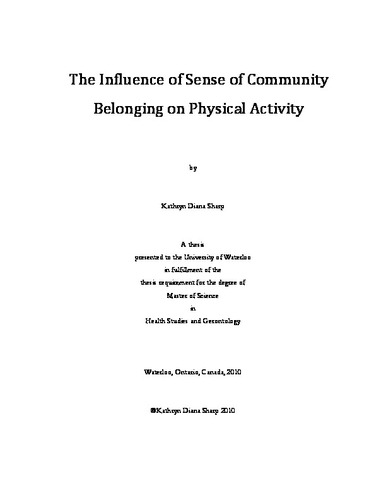| dc.contributor.author | Sharp, Kathryn | |
| dc.date.accessioned | 2010-08-06 17:15:58 (GMT) | |
| dc.date.available | 2010-08-06 17:15:58 (GMT) | |
| dc.date.issued | 2010-08-06T17:15:58Z | |
| dc.date.submitted | 2010 | |
| dc.identifier.uri | http://hdl.handle.net/10012/5328 | |
| dc.description.abstract | Feeling connected to one’s community has been associated with increased self-rated health and well-being. Connectivity has also been linked to health behaviours such as smoking and obesity, which have been related to overall health status. Physical activity is related to overall health status as it protects against many chronic diseases. Unfortunately, less than 50% of Canadian adults are meeting the physical activity requirements set out by Canada’s Physical Activity Guide to Healthy Living. Thus, this study determines whether sense of connectedness is associated with current participation in leisure-time physical activity and intention to start or increase engagement in physical activity.
Cross-sectional data from the Canadian Community Health Survey (CCHS) cycle 3.1 was used to analyze the association between sense of community belonging and physical activity among Canadians aged 25 to 64. A series of logistic regression models were used to analyze the data.
People reporting a stronger sense of connectedness had greater odds of being physically active with income, education and sex often moderating the relationship. It appeared that the relative odds of being physically active were greatest among people who felt very strongly connected to their communities and in the highest socioeconomic groups. Further, feeling more that very weakly connected to the community increased the odds of intending to start or increase physical activity among inactive females and decreased the odds of intending to increase physical activity among moderately active males.
This study provides preliminary results regarding how important social factors may alter population level physical activity. The results from this study inform our understanding of barriers and facilitators associated with physical activity and how policies and conditions which affect community connectedness may be used to enhance physical activity. | en |
| dc.language.iso | en | en |
| dc.publisher | University of Waterloo | en |
| dc.subject | community belonging | en |
| dc.subject | physical activity | en |
| dc.subject | connectedness | en |
| dc.subject | intentions | en |
| dc.title | The influence of community belonging on physical activity | en |
| dc.type | Master Thesis | en |
| dc.pending | false | en |
| dc.subject.program | Health Studies and Gerontology | en |
| uws-etd.degree.department | Health Studies and Gerontology | en |
| uws-etd.degree | Master of Science | en |
| uws.typeOfResource | Text | en |
| uws.peerReviewStatus | Unreviewed | en |
| uws.scholarLevel | Graduate | en |

